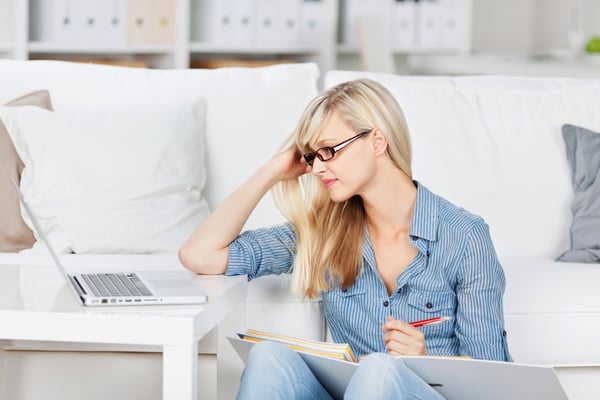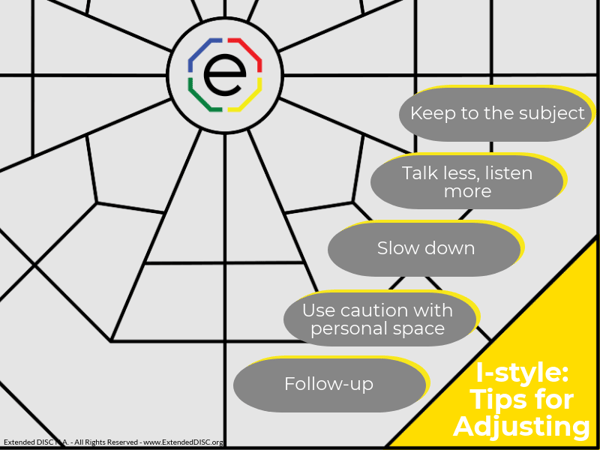Have you ever wondered if learning styles can be applied to DISC?
 Do we ever stop learning? Oftentimes, we equate learning styles to a school classroom and we forget that learning styles remain with us throughout adulthood. We are still expected to learn new things each day; though we are at work, rather than the traditional classroom setting.
Do we ever stop learning? Oftentimes, we equate learning styles to a school classroom and we forget that learning styles remain with us throughout adulthood. We are still expected to learn new things each day; though we are at work, rather than the traditional classroom setting.
How many of you had to learn how to work remotely this year? Each day we encounter new challenges and opportunities that help us grow and learn. How do you like to learn? Do you prefer to jump in and do it or do you prefer to observe before trying it yourself? DISC provides us with insights into our learning styles, based on our preferred, natural behaviors.
First, let's review DISC
 DISC is a non-judgmental tool used to assess a person's most natural comfortable style. The four-quadrant DISC model was created by William Marston, based on Carl Jung's 2-axis four-quadrant theory of human behavior.
DISC is a non-judgmental tool used to assess a person's most natural comfortable style. The four-quadrant DISC model was created by William Marston, based on Carl Jung's 2-axis four-quadrant theory of human behavior.
The Extended DISC system is an internationally validated assessment tool that measures a person's hard-wired DISC style. A person finds at least 1-3 styles that are more natural and comfortable for them than the other styles. Some of the styles share an axis and others do not. There is no right or wrong style. They are simply different. Let's take a closer look at the 4 DISC styles.
D-styles tend to be more task-oriented and active. They are decisive and results focused. I-styles are also active, but they are more people-oriented. They are a spontaneous style who are good at persuading and promoting ideas and others. S-styles are people-oriented, but they are reserved. They prefer listening over speaking and will inquire about specific details. C-styles are reserved and task-oriented. They have a systematic approach to everything and tend to focus on data, facts, and analyses.
Why use DISC?
At Extended DISC, knowing about your own DISC style is only one of four steps to effective interactions. We can make better behavioral adjustments to improve our interactions when we know our own style and we know about the style preferences of others.
Understanding a person's preferred style provides us with information about how they prefer to communicate, listen, delegate, make decisions, negotiate, etc. Now we have valuable information to make better adjustments. Ultimately, successful people have a keen self-awareness and the ability to modify behaviors effectively for a situation and/or person.
However, we should not forget, everyone has all four DISC styles. DISC simply measures one's more dominant, natural style. We all have all four styles within us; some are simply more natural and some take more energy. After all, we are complex human beings.
Using learning styles and DISC
 There are a lot of learning style models. For our purposes, we'll use Kolb's Learning Styles. In Kolb's theory there are four distinct learning styles. His theory fits nicely with DISC because both are based on a 2 axis, 4 quadrant model.
There are a lot of learning style models. For our purposes, we'll use Kolb's Learning Styles. In Kolb's theory there are four distinct learning styles. His theory fits nicely with DISC because both are based on a 2 axis, 4 quadrant model.
The vertical axis for Kolb's theory is 'Feeling' versus 'Thinking'. It is similar to the vertical axis in Extended DISC which is 'Task-oriented' versus 'People-oriented'. The horizontal axis in Kolb's theory is 'Watching' versus 'Doing', and in the Extended DISC® Model it is 'Active' versus 'Reserved'.
Kolb explains how each person naturally prefers one learning style more than another. Similarly, Extended DISC also is based on individuals preferring one DISC style more than another. The four learning styles in Kolb's theory are: diverging, assimilating, converging, and thinking. Let's look at how they are defined and how they relate to DISC.
Diverging learning styles and S-styles
 Diverging learning styles prefer to 'watch' versus 'do'. They tend to view concrete situations from many different perspectives and can also be sensitive. In my opinion, the diverging learning style sounds a lot like the S-style in DISC. Remember, S-styles are people-oriented; which can make them a more sensitive style compared to others. They are also a steady style who prefer to work in proven theories versus the unknown. S-styles tend to consider other people and focus on agreements.
Diverging learning styles prefer to 'watch' versus 'do'. They tend to view concrete situations from many different perspectives and can also be sensitive. In my opinion, the diverging learning style sounds a lot like the S-style in DISC. Remember, S-styles are people-oriented; which can make them a more sensitive style compared to others. They are also a steady style who prefer to work in proven theories versus the unknown. S-styles tend to consider other people and focus on agreements.
One way to use this with DISC is getting them into groups to discuss and brainstorm ideas. They enjoy collaborating in cooperative groups.
Assimilating learning styles and C-styles
 Assimilating learning styles prefer a concise logical approach. They require clear explanation and need time to think things through. 'Why do you think that?' sounds like a classic C-style. C-styles are logical, careful, thorough, systematic, exact, and analytical.
Assimilating learning styles prefer a concise logical approach. They require clear explanation and need time to think things through. 'Why do you think that?' sounds like a classic C-style. C-styles are logical, careful, thorough, systematic, exact, and analytical.
The Assimilating learning style and C-style both want data; give them graphs and charts. They both want you to show them proof and give them time to process and decide. They prefer lectures, presentations, reading materials, and watching demonstrations.
Converging learning styles and D-styles
 Converging learning styles can make decisions and solve problems. They prefer to focus on tasks, rather than people. Likewise, D-styles are decisive and comfortable with crisis situations and constant change. They appear abrasive due to their focus on results and the task at hand, rather than focusing on people.
Converging learning styles can make decisions and solve problems. They prefer to focus on tasks, rather than people. Likewise, D-styles are decisive and comfortable with crisis situations and constant change. They appear abrasive due to their focus on results and the task at hand, rather than focusing on people.
This style wants to start right away. Give them simulations to allow them to try things out on their own. They will also prefer individual work versus working in a group.
Accomodating learning styles and I-styles
 Accommodating learning styles tend to act on 'gut' instinct and are more adaptable. They prefer implementing and advocating, rather than creating their own analysis. I-style is also known as the influencing style. They are a charismatic, impulsive, inspiring, spontaneous kind of DISC style. They prefer to stay away from details and unpleasant topics.
Accommodating learning styles tend to act on 'gut' instinct and are more adaptable. They prefer implementing and advocating, rather than creating their own analysis. I-style is also known as the influencing style. They are a charismatic, impulsive, inspiring, spontaneous kind of DISC style. They prefer to stay away from details and unpleasant topics.
This style will also enjoy simulations; but they also enjoy working in a group. They are also comfortable with giving presentations; perhaps a teach back.
Using DISC to support learning styles
Knowing a person's (and your own) learning style enables learning to be tailored to their preferred style. That being said, everyone needs all four types of learning styles to one extent or another. Just like we all have all four DISC styles within us. It's a matter of understanding the given situation, a person's learning style preference, and then making the necessary adjustments to meet their learning style needs. People will tend to feel more motivated and receptive to the learning process.
The next time you need to learn something new (or teach something to someone else) don't just consider learning styles; also think also about DISC.
How does your DISC style impact how you prefer to learn?
